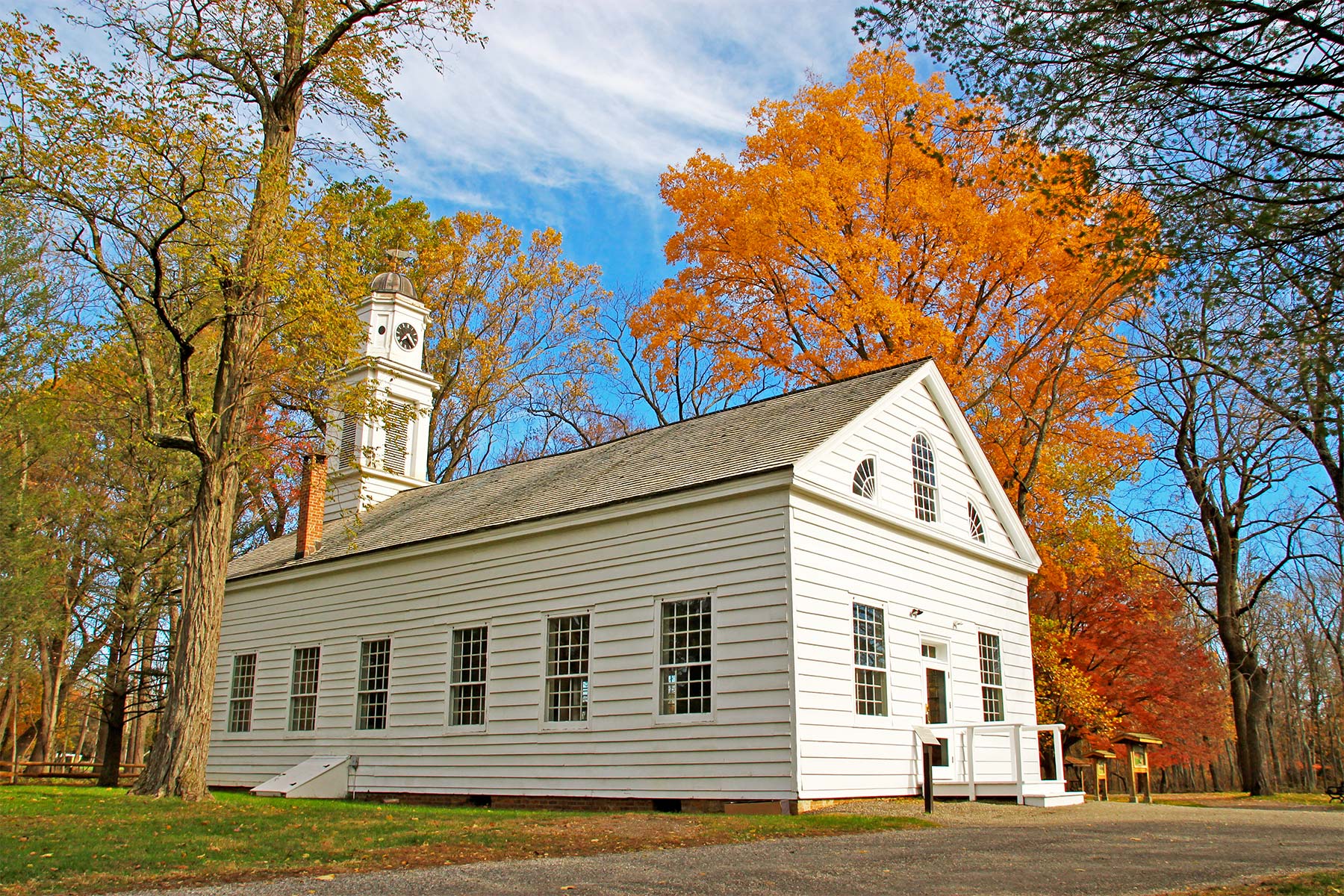
Article Summary: Historic Sites In New jersey
Historic Sites In New Jersey. More Than Just Parks has 15 incredible must-see sites for you to visit.
I’ve been to so many of these amazing places since retiring from teaching in 2018. Did I mention that I taught history? I spent a lifetime teaching about the history behind these momentous sites. Then I got to see them firsthand. And now I’m sharing the stories of these incredible places with you. It doesn’t get any better than that!
I’m going to give you my list of the 15 Historic Sites In New Jersey that you’ll want to see.
To be clear, this list includes national park sites (as in sites managed by the National Park Service) as well as national parks. It also includes sites not managed by the National Park Service. After all, we’re more than just parks!
If you’re planning a trip to the Garden State then one book that I highly recommend is: New Jersey Off the Beaten Path: A Guide To Unique Places by Bill Scheller.
Without further ado, let’s dive in.
Top 15 Historic Sites In New Jersey
Table Of Contents: Historic Sites In New Jersey
15. Lambert Tower
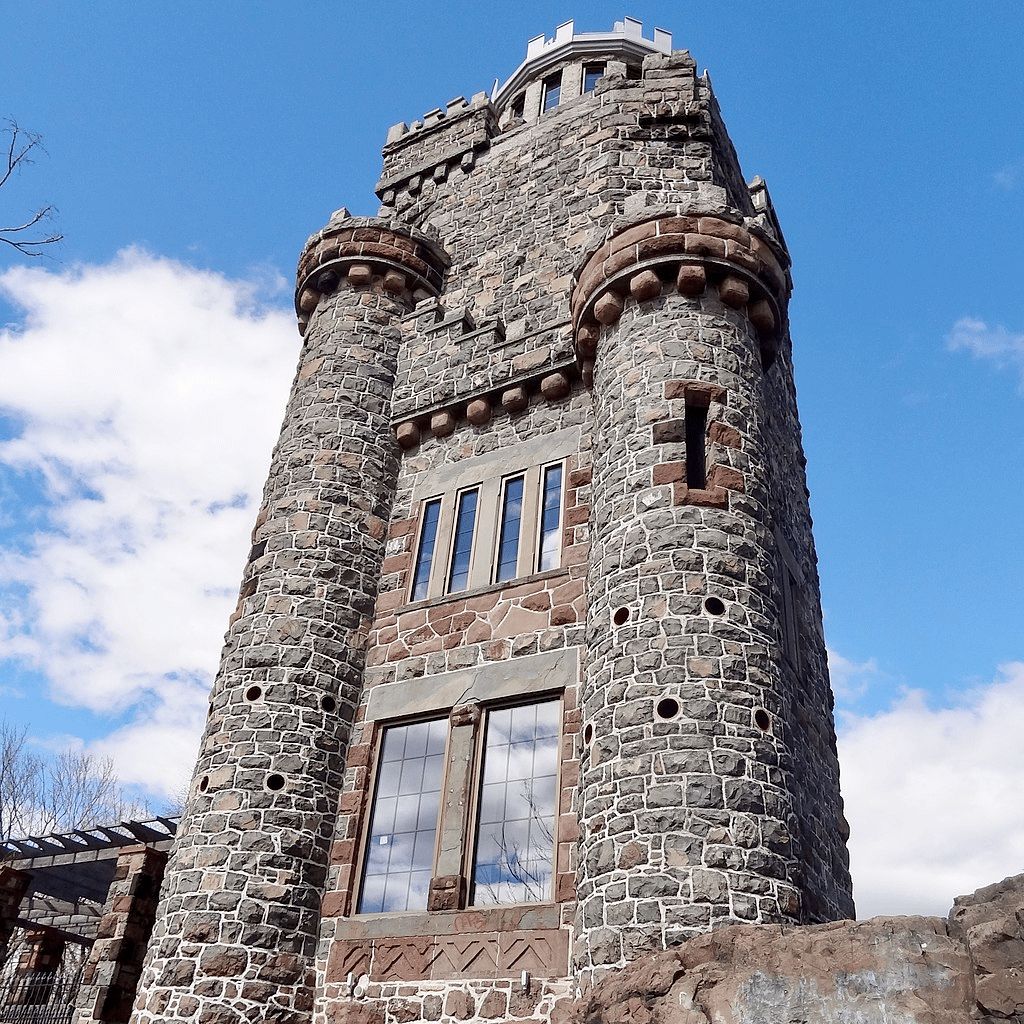
New Jersey is known for its beautiful beaches, casinos, entertaining boardwalks, and untouched nature. With its crucial role in American history and distinctive culture today, there is much to discover. And we’ve got 15 amazing historic sites for you to see on your next visit to New Jersey.
We kick-off our list at #15 with historic Lambert Tower.
Lambert Tower is a historic structure located in the town of Paterson, New Jersey. The tower was built in 1896 by the Lambert family, who were prominent members of the local community and owned a silk mill in the area.
The tower was constructed as a memorial to John Lambert, the founder of the Lambert Silk Company and a well-known philanthropist. Lambert was a major benefactor of the city of Paterson, and his contributions to the community included the construction of parks, schools, and other public facilities.
It’s An Amazing Structure
The tower is made of local granite and stands 85 feet tall. It features a circular base and a tapered shaft that rises to a pointed spire at the top. The tower was designed in the Richardsonian Romanesque style, which was popular in the late 19th century and characterized by its use of heavy stone masonry and rounded arches.
The Lambert family donated the tower and the surrounding parkland to the city of Paterson in 1914. The tower has since become a popular landmark in the area and is listed on the National Register of Historic Places.
In addition to its historical significance, Lambert Tower offers visitors a stunning panoramic view of the surrounding countryside. The tower’s observation deck is accessible via a winding staircase that leads to the top of the spire. From there, visitors can see miles of rolling hills, forests, and farmland.
Today, Lambert Tower is open to the public and is a popular destination for tourists and locals alike. The tower and its surrounding parkland are maintained by the city of Paterson, and visitors can take guided tours of the tower and learn more about its history and significance.
14. Absecon Lighthouse
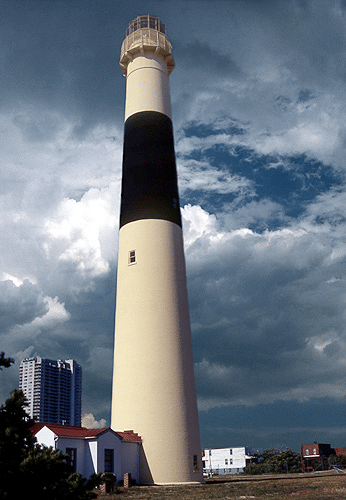
Out next historic site is a different type of tower. At #14 on our list of the Best Historic Sites In New Jersey is the Absecon Lighthouse.
The Absecon Lighthouse is a historic lighthouse located in Atlantic City, New Jersey. It was built in 1857 to help guide ships safely through the treacherous waters off the coast of New Jersey.
At the time of its construction, the Absecon Lighthouse was the tallest lighthouse in the United States, standing at 171 feet tall. The lighthouse was built on Absecon Island, which was a popular destination for shipping traffic due to its strategic location near the entrance to the Delaware Bay.
A Major Engineering Feat Of Its Time
The construction of the Absecon Lighthouse was a major engineering feat of its time.
The lighthouse was built of brick and stone and featured a spiral staircase that led to the top of the tower. The lighthouse was also equipped with a Fresnel lens, which was a cutting-edge technology at the time and provided a powerful beam of light that could be seen from miles away.
The Absecon Lighthouse remained in operation until 1933, when it was decommissioned and replaced by a modern navigational system. The lighthouse fell into disrepair and was eventually abandoned.
In the 1990s, a group of local residents formed the Absecon Lighthouse Preservation Society to restore and preserve the historic structure. The society worked tirelessly to raise funds and gather support for the project, and in 1999, the lighthouse was opened to the public for the first time in over 60 years.
Today, the Absecon Lighthouse is a popular tourist destination and a symbol of Atlantic City’s rich maritime heritage. Visitors can climb the spiral staircase to the top of the tower and enjoy stunning views of the Atlantic Ocean and the surrounding coastline.
The lighthouse also features a museum that showcases the history of the lighthouse and the role it played in guiding ships through the treacherous waters off the coast of New Jersey.
13. Weehawken Dueling Grounds
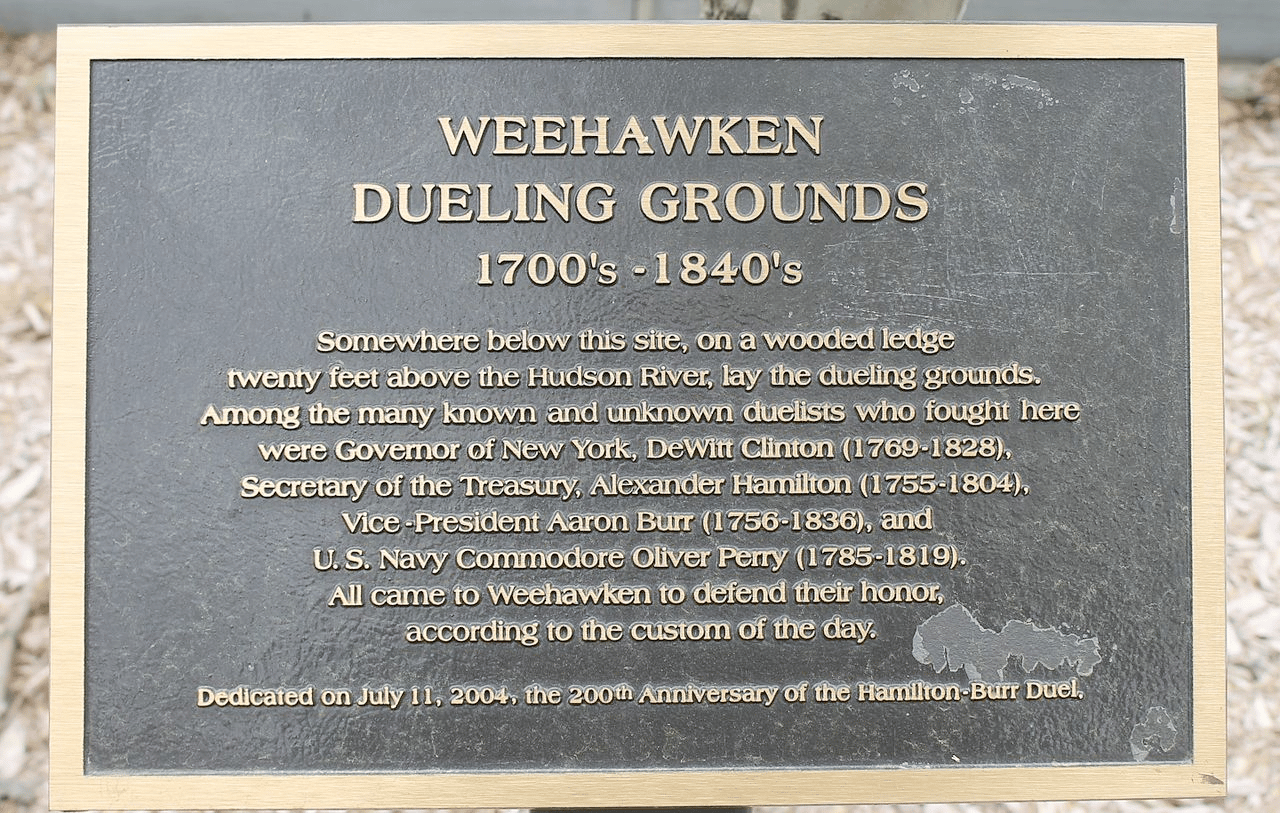
Thirteen is an unlucky number and our next historic site in New Jersey was definitely unlucky for one of America’s Founding Fathers. At #13 on our list of the Best Historic Sites In New Jersey is the Weehawken Dueling Grounds.
The Weehawken Dueling Grounds is a historic site located in Weehawken, New Jersey, that was once a popular location for duels in the early 19th century. The site is located on a bluff overlooking the Hudson River, and it is believed that dozens of duels took place there between the late 1700s and the mid-1800s.
The practice of dueling was common among members of the upper classes in the early United States. Duels were typically fought with pistols, and the objective was to defend one’s honor and reputation.
The Weehawken Dueling Grounds became a popular location for these contests because it was easily accessible from New York City, which was the center of social and political life at the time.
The Hamilton-Burr Duel
The Hamilton-Burr Duel was a famous duel between two prominent American statesmen, Alexander Hamilton and Aaron Burr, that took place on July 11, 1804. The duel was the culmination of a long-standing feud between the two men, which was fueled by political and personal differences.
Alexander Hamilton was a founding father of the United States and a leading Federalist, while Aaron Burr was a Democratic-Republican and the sitting Vice President of the United States.
The rivalry between the two men reached a boiling point when Burr ran for governor of New York in 1804 and Hamilton publicly spoke out against him, contributing to his defeat.
The duel took place in Weehawken, New Jersey, and was fought with pistols. Both men fired shots, with Hamilton being mortally wounded and dying the following day. Burr, who was charged with murder, fled to South Carolina and was later arrested and charged with treason. He was eventually acquitted of both charges.
The duel had far-reaching consequences, both for the individuals involved and for American history. Hamilton’s death was a significant loss for the Federalist Party and left a void in American politics.
The event also brought public attention to the issue of dueling, which was already in decline, and helped to further discredit the practice in the eyes of the American public.

Weehawken Today
After the Hamilton-Burr duel, public opinion turned against dueling, and the practice began to decline in popularity. The Weehawken Dueling Grounds fell into disuse and was eventually forgotten. In the 1890s, the site was rediscovered by local historians, and efforts were made to preserve it as a historic site.
Today, the Weehawken Dueling Grounds are a popular tourist destination and a reminder of the early history of the United States.
The site includes a monument to Hamilton, as well as interpretive signs that provide information about the history of dueling and the events that took place at the site.
Visitors can also enjoy stunning views of the Hudson River and the Manhattan skyline.
12. William Trent House Museum
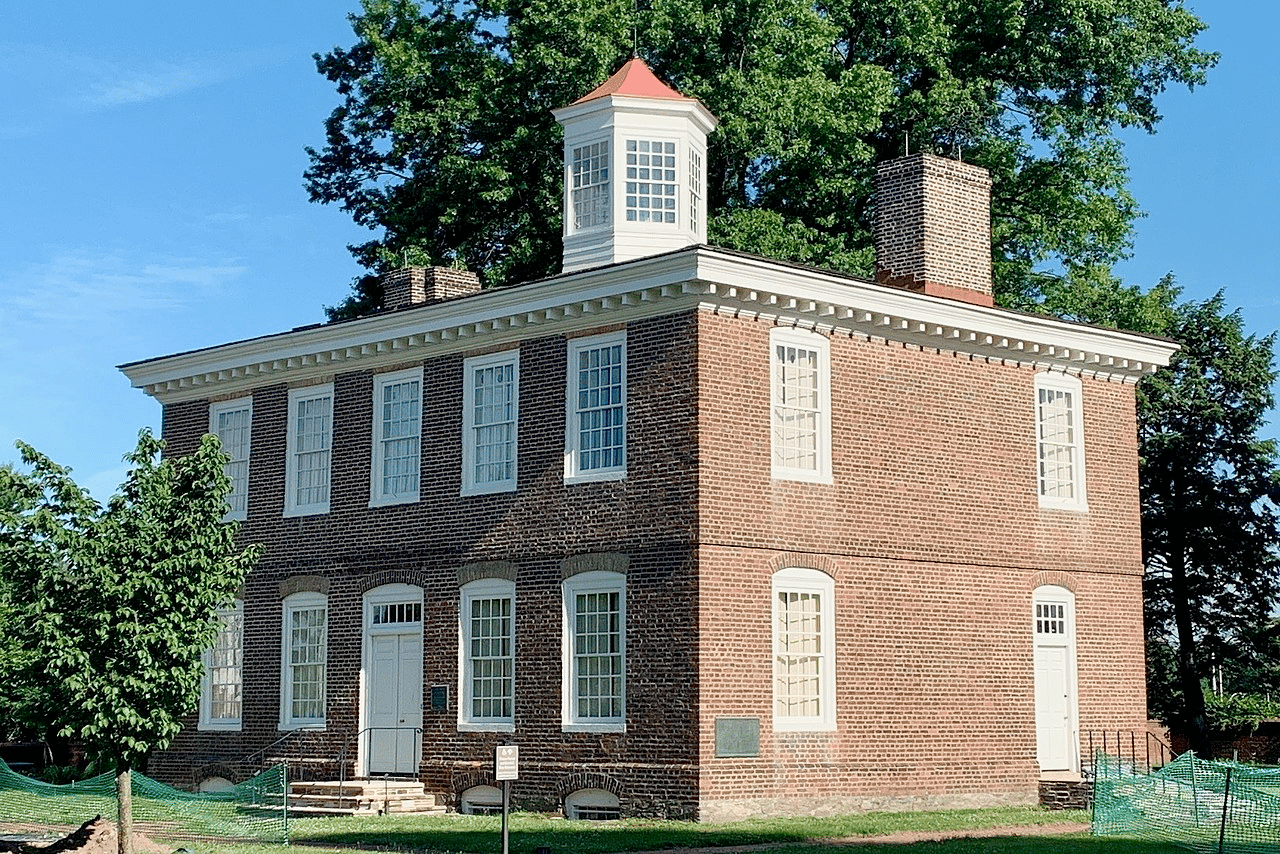
Next up is a site that celebrates a man who played an important role in the history of New Jersey. At #12 on our list of the Best Historic Sites In New Jersey is the William Trent House Museum.
The William Trent House Museum is located in Trenton, New Jersey. It was built in 1719 by William Trent, a prominent merchant and trader in the area.
The house is an example of 18th-century architecture and has been well-preserved over the years. It is a two-story brick building with a gable roof and features a Georgian-style design.
The house was used as a residence for William Trent and his family until the late 18th century, after which it was used for various purposes such as a tavern, a boarding house, and a store.
In the 1930s, the house was purchased by the Trenton Historical Society and was restored to its original 18th-century appearance. It was opened to the public as a museum in 1939.
Learn About The History Of Trenton
The William Trent House Museum features exhibits on the history of Trenton and the Trent family, as well as on 18th-century life and culture. Visitors can tour the house and see the restored period rooms, including the parlor, dining room, and bedrooms.
The Museum also has a collection of 18th century Trent family artifacts and decorative arts on display.
The William Trent House Museum is open to the public for tours and is an important historical site in Trenton and New Jersey. It is also listed on the National Register of Historic Places.

11. The Sterling Hill Mining Museum
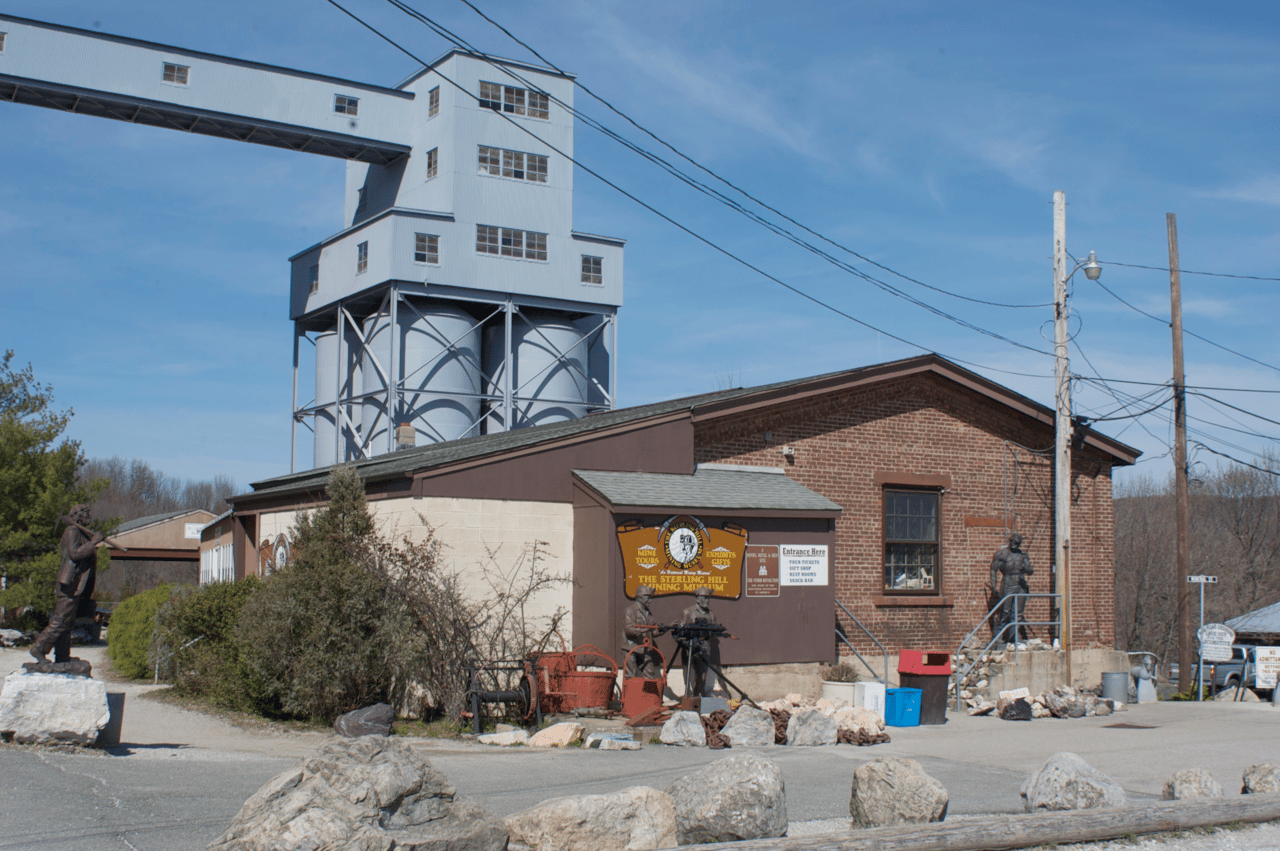
In compiling our list of the best historic sites we look for places which are sometimes off of the beaten path, but have a fascinating story to tell nonetheless. Our next site is just such a place.
One of the lesser known historic sites in New Jersey is the Sterling Hill Mining Museum. It’s a mining museum located in Ogdensburg, New Jersey. It is situated on the site of the former Sterling Hill zinc mine, which was once one of the largest and most productive zinc mines in the world. The mine operated from the 1730s to 1986.
The museum features exhibits on the history of mining in the area, including the mining methods and technology used at the Sterling Hill mine.
Visitors can tour the mine’s underground tunnels and see the different types of mineral deposits that were mined, including fluorescence minerals. There is also an exhibit on the miners and their families, including their living and working conditions.
The museum also features an extensive collection of minerals and rocks, including many rare and fluorescent specimens. In addition, it has an educational program for schools and other groups, including underground mine tours, mineral collecting, and mining history.
The Sterling Hill Mining Museum is open to the public and offers various activities such as mineral collecting, underground mine tours and educational programs, making it an important educational and historical site in New Jersey.
Top 10 Historic Sites In New Jersey
10. Monmouth Battlefield
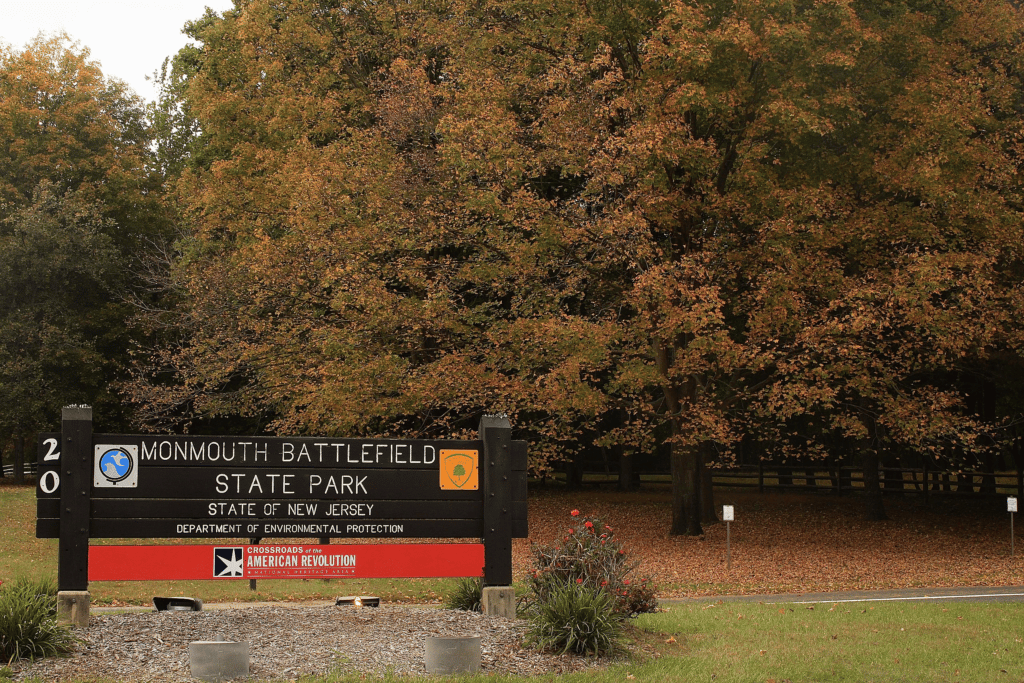
We move on to our list of the Top 10 Historic Sites In New Jersey. At #10 is a place which served as a site of a significant battle fought during the American Revolutionary War. At #10 is the Monmouth Battlefield.
Historic Monmouth Battlefield State Park is located in Freehold, New Jersey.
The Battle of Monmouth was fought on June 28, 1778, between the Continental Army, led by General George Washington, and the British Army, led by Sir Henry Clinton. It was one of the largest battles of the Revolutionary War, with an estimated 15,000-20,000 soldiers participating.
The battle was significant because it was the first time that the Continental Army stood up to the British in a large-scale battle and held their own, rather than withdrawing as they had done in previous engagements.
The battle was also notable for the participation of women, including Molly Pitcher, who is said to have carried water to the soldiers during the battle and to have fired a cannon when her husband was unable to do so.
The Park Was Used For Farming
After the battle, the park was used for farming and other activities, but in the early 20th century, it was acquired by the State of New Jersey and was designated as a historic site.
Today, the park features a visitors center, a museum, and several miles of hiking trails that interpret the history of the battle and the surrounding area. It also has reconstructed earthworks and a restored 18th-century farmhouse that serve as a living history museum.
Monmouth Battlefield State Park is an important historical site and offers an opportunity to learn about the American Revolutionary War and the Battle of Monmouth. It is also listed on the National Register of Historic Places.

Things To Do At Monmouth Battlefield State Park
Here are some things to do at the park:
- Visit the Visitor Center: The Visitor Center has exhibits on the American Revolution, the Battle of Monmouth, and the history of the park.
- Hike the Trails: The park has several hiking trails that offer beautiful views of the battlefield and surrounding countryside. The trails range in difficulty and distance, so there is something for every level of hiker.
- Tour the Battlefield: The park offers guided tours of the battlefield, which cover the events of the battle and the strategies used by the American and British armies.
- Attend Living History Events: Throughout the year, the park hosts living history events where actors dressed in period clothing reenact scenes from the American Revolution.
- Picnic: The park has several picnic areas where visitors can enjoy a meal and take in the scenery.
- Fishing: The park has a pond stocked with fish, which is open for fishing year-round.
- Cross-Country Skiing: In the winter, the park has cross-country skiing trails that are open for skiing.
- Attend Special Events: The park hosts a variety of special events throughout the year, including historical reenactments, nature walks, and art exhibits.
- Bird Watching: The park is home to a variety of bird species, including hawks, owls, and woodpeckers, making it a great location for bird watching.
- Photography: With its historic sites and beautiful scenery, the park is an excellent location for photography.

CHECK OUT: 10 BEST Revolutionary War Sites In America
9. Allaire Village

Another site which is sometime overlooked, but one which we definitely believe belongs on any Top 10 List of the Best Historic Sites In New Jersey is Allaire Village.
Allaire Village is a living history museum located in Farmingdale, New Jersey. It is situated on the site of the historic Allaire Iron Works, which was one of the most important iron manufacturing sites in New Jersey during the 19th century.
The village was created to preserve the remaining buildings and structures of the iron works and to interpret the history of the area and the people who lived and worked there.
The village features several restored and reconstructed buildings, including a blacksmith shop, a carpenter shop, a manager’s house, and a church. Visitors can tour the buildings and see how people lived and worked during the 19th century.
The Allaire Village is also the home of the Allaire State Park and the Pine Creek Railroad, a narrow gauge railway that offers rides through the park. The village also offers educational programs, special events and reenactments, and seasonal activities such as blacksmithing demonstrations, candle making, and other traditional crafts.
Allaire Village is a unique opportunity to learn about the history of New Jersey and the lives of the people who lived and worked in the 19th century. It is also listed on the National Register of Historic Places.
8. Grover Cleveland Birthplace
Our next historic site celebrates the only man in American history to be elected President of the United States twice – to non consecutive terms. Did you ever wonder why the number of people to have held the Presidency of the United States is less than the number of Presidents?
The answer is Grover Cleveland who happens to be both the 22nd and 24th President of the United States. At #8 on our list of the Best Historic Sites In New Jersey is the Grover Cleveland Birthplace.
Although not a great President, Grover Cleveland almost single-handedly restored and strengthened the power and autonomy of the executive branch.
Notable in this regard was his use of executive privilege in refusing to hand over department files to Congress in the fight over presidential appointments.
His record-breaking use of the presidential veto also enabled him to reestablish the equilibrium between the executive and legislative branches, another precedent-setting example of presidential power.
Equally important, Cleveland laid claim to a strong presidency in ways that had lasting impact. His assertion of authority in calling out federal troops during the Pullman strike, sending warships to Panama, and threatening Britain with war over the Venezuelan boundary dispute set the tone for the modern energetic executive. (Source: The Miller Center)
To learn more about Grover Cleveland, I recommend Grover Cleveland, A Study in Courage by Allan Nevins.

Grover Cleveland’s Birthplace
Cleveland was born in a modest house in Caldwell, New Jersey on March 18, 1837.
It’s worth noting that Grover Cleveland was the 22nd and 24th president of the United States, the only president to serve two non-consecutive terms.
According to the National Park Service, The Grover Cleveland Birthplace State Historic Site is the only house museum in the country dedicated to the interpretation of President Cleveland’s life. It is the nation’s leading repository of Cleveland artifacts and political memorabilia.
Restored to their 1837 appearance when the Cleveland family lived in the house, the first floor rooms offer a glimpse at the modest beginnings of the future president.
Among the artifacts on display from Cleveland’s early years are his cradle and original family portraits. An exhibition gallery reflects his later life.
CHECK OUT: 20 MUST-SEE Historic Sites In New York
7. Appalachian National Scenic Trail
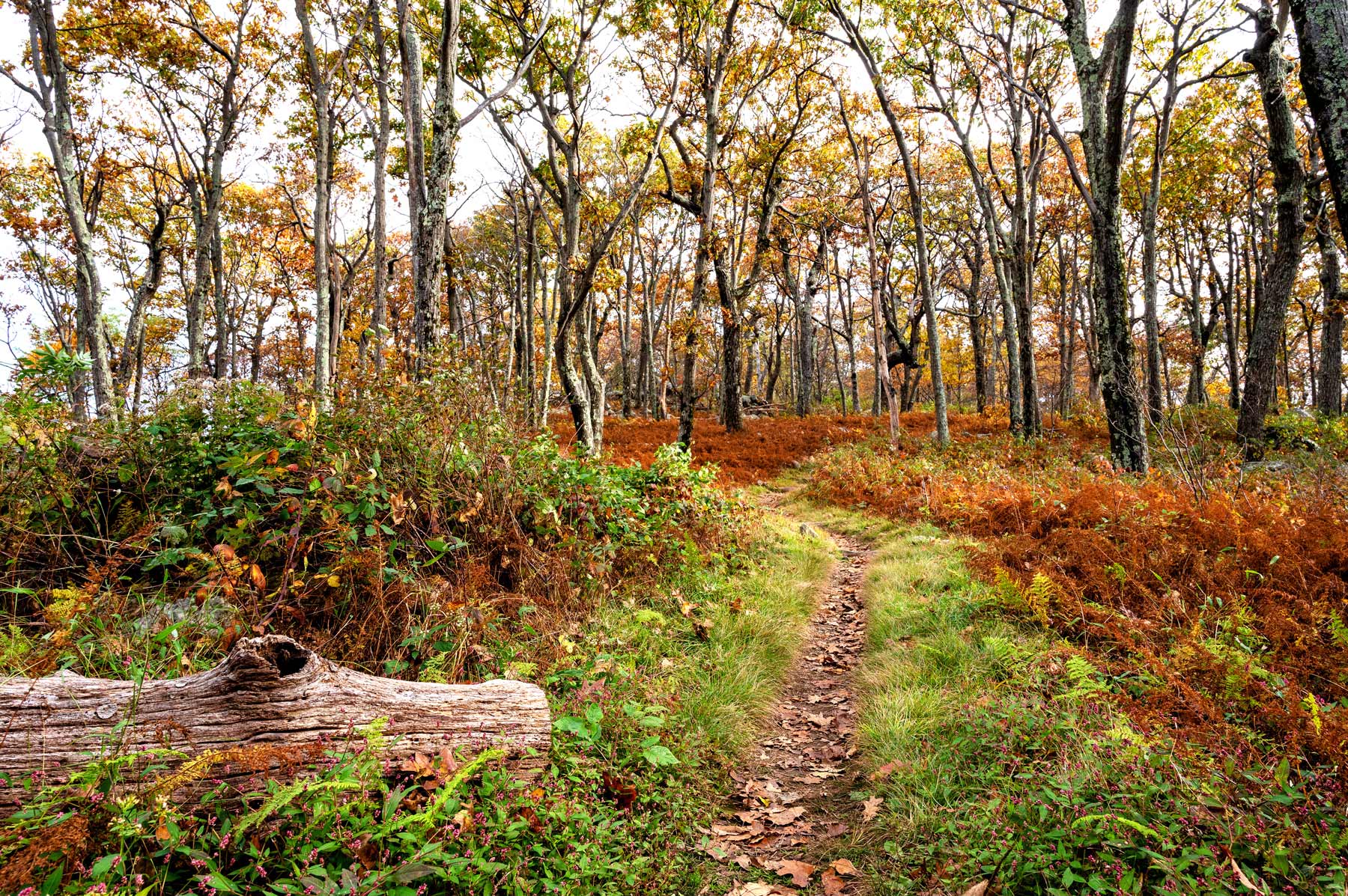
We move from a site which celebrates an American President to one which is one of the most famous hiking trails in the world. At #7 on our list of the Best Historic Sites In New Jersey of the Appalachian National Scenic Trail.
The Appalachian National Scenic Trail, commonly known as the Appalachian Trail or simply the AT, is a long-distance hiking trail that runs for approximately 2,200 miles through the eastern United States, from Springer Mountain in Georgia to Mount Katahdin in Maine.
The trail passes through 14 states, including Georgia, North Carolina, Tennessee, Virginia, West Virginia, Maryland, Pennsylvania, New Jersey, New York, Connecticut, Massachusetts, Vermont, New Hampshire, and Maine.
The idea of creating a trail along the Appalachian Mountains was first proposed in the 1920s by Benton MacKaye, a regional planner and conservationist.
In 1921, he wrote an article in the Journal of the American Institute of Architects proposing the creation of a “Appalachian Trail” that would provide a recreational opportunity for urban dwellers and a way to preserve the natural beauty of the Appalachian Mountains.
It Was Completed By The Civilian Conservation Corps
The trail was officially completed in 1937, after more than a decade of work by volunteers and the Civilian Conservation Corps.
The trail is maintained by the National Park Service and the Appalachian Trail Conservancy, a non-profit organization that works to preserve and protect the trail.
The Appalachian Trail is one of the most popular long-distance hiking trails in the world and is known for its scenic beauty, cultural and historical significance, and the sense of accomplishment that comes from completing the entire trail.
Hiking the entire trail is a major accomplishment, known as a “through-hike” and it typically takes 5-7 months.
The Appalachian Trail is also an important ecological corridor and is home to a wide variety of plant and animal species. It is also listed on the National Register of Historic Places and is protected by the National Scenic Trail System Act of 1968.

CHECK OUT: 15 MUST-SEE Historic Sites In Ohio
6. Washington-Rochambeau Revolutionary Route National Historic Trail
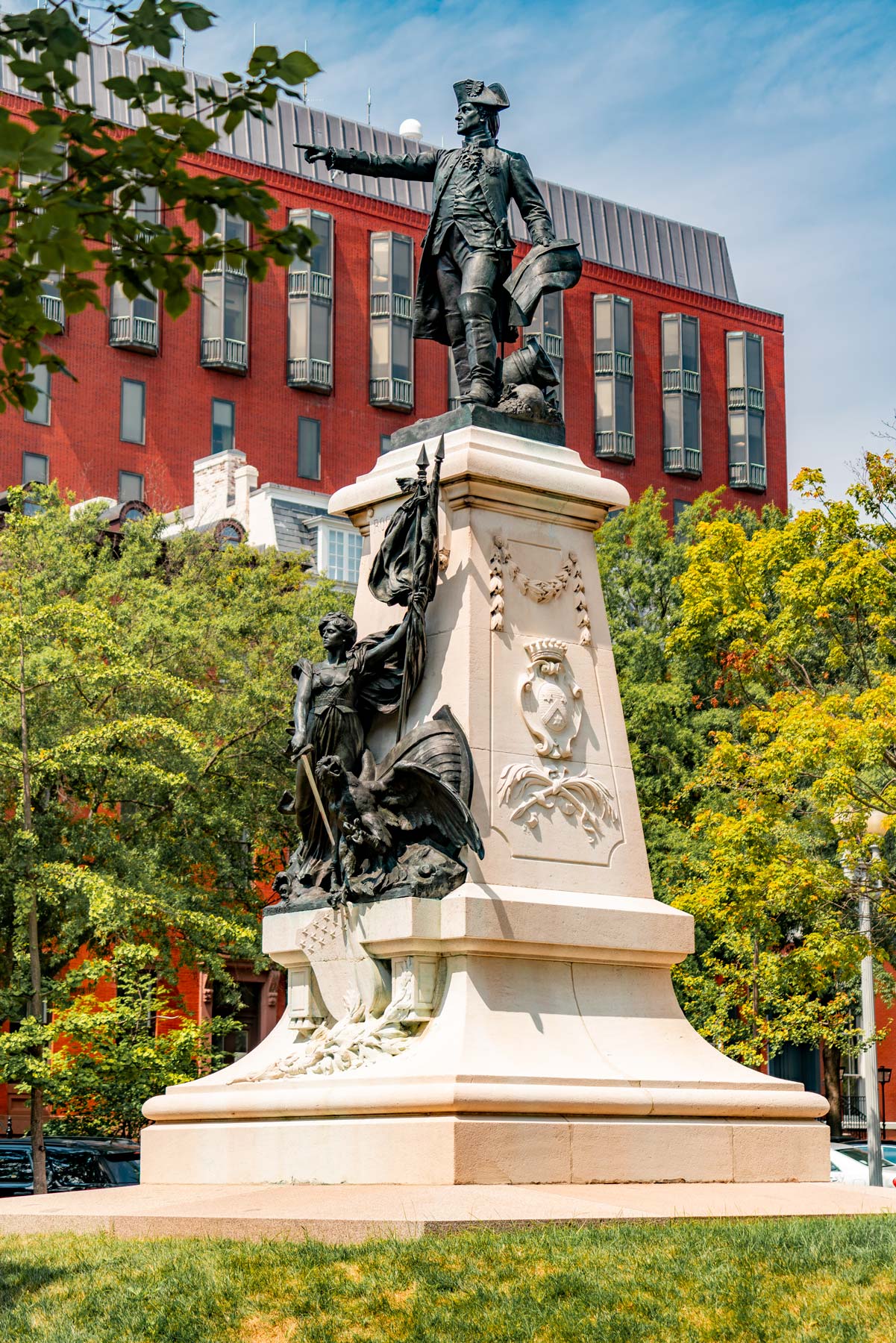
George Washington’s ultimate success against the British was made possible through an alliance with France. At #6 is a site which celebrates this historic alliance. It’s the Washington-Rochambeau Revolutionary Route National Historic Trail.
On July 11, 1780, 55-year-old General Jean Baptiste Donatien de Vimeur, comte de Rochambeau arrived with an army of 450 officers and 5,300 men in Narragansett Bay off Newport, Rhode Island.
This marked the beginning of a most successful military cooperation that culminated 15 months later in the victory at Yorktown and the surrender of Lord Cornwallis and his troops.
From New Hampshire to Virginia, the Washington-Rochambeau National Historic Trail connects major metropolitan areas, state and national parks, historic and scenic trails, and countless other historic sites.
The rout is a 680-mile series of roads used in 1781 by the Continental Army under the command of George Washington and the forces under the command of Admiral Rochambeau during their 14-week march from Newport, Rhode Island, to Yorktown, Virginia.
Check Out: 10 BEST Revolutionary War Sites In America
Top Historic Sites In New Jersey
5. Paterson Great Falls National Historical Park
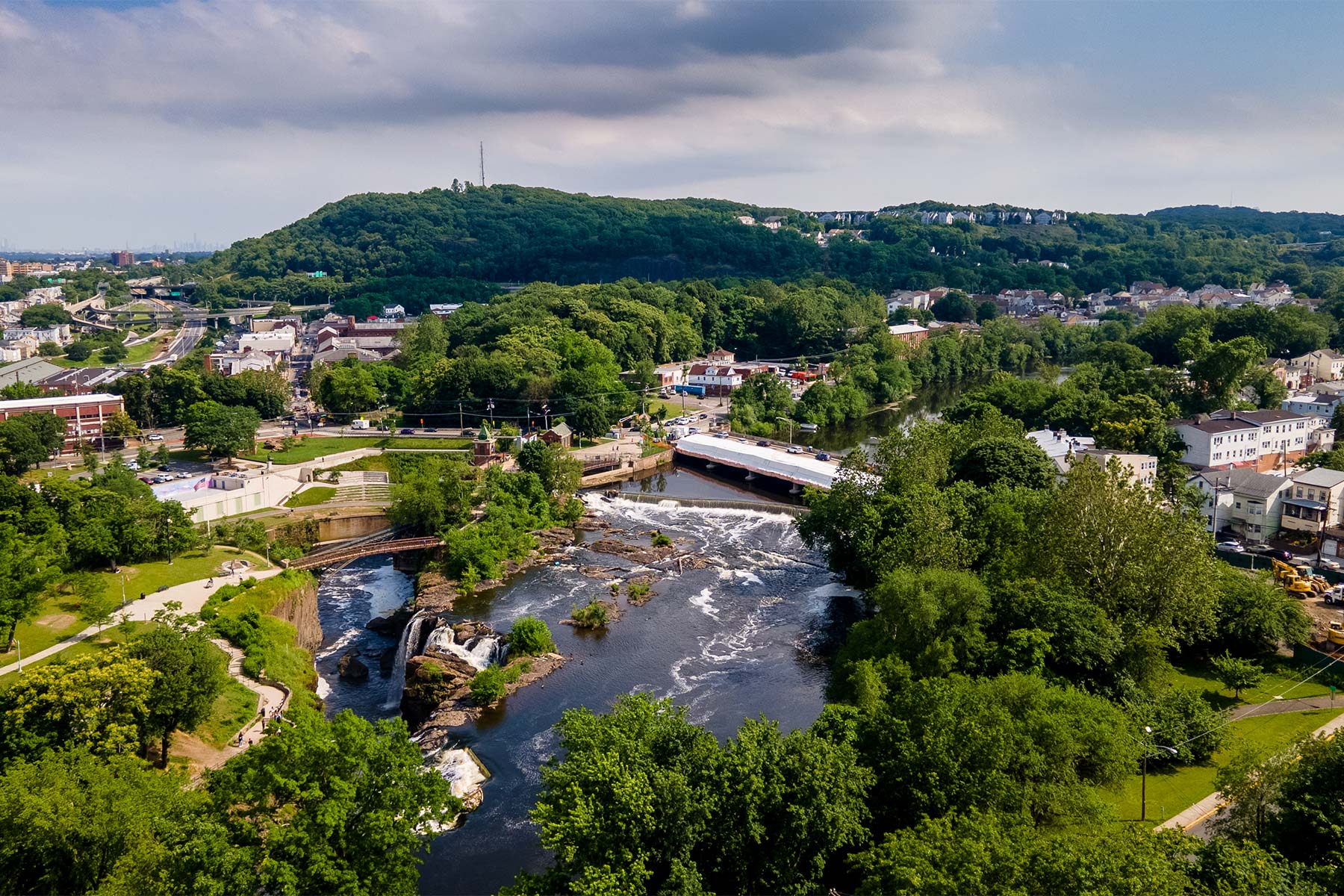
We’re on to our Top 5 Historic Sites In New Jersey. At #5 we have Paterson Great Falls National Historical Park.
Paterson Great Falls National Historical Park is a protected area located in the city of Paterson, New Jersey. The park was established in 2009 to preserve and interpret the industrial history of the city, particularly the role played by the Great Falls of the Passaic River in the development of the American textile industry.
The Great Falls of the Passaic River, located in the heart of Paterson, were an important source of power for early American industry.
In the late 18th century, Alexander Hamilton, the first Secretary of the Treasury, recognized the potential of the falls to power manufacturing machinery, and he encouraged the establishment of textile mills and other industrial enterprises in the area.
A Hub Of The American Textile Industry
Over the next century, Paterson became a hub of the American textile industry, with dozens of mills and factories producing cotton, silk, and other textiles. The Great Falls remained a central feature of the city’s industrial landscape, providing power to the mills and factories that lined the banks of the Passaic River.
The establishment of Paterson Great Falls National Historical Park was an effort to preserve the industrial heritage of the city and to make it accessible to visitors. The park includes the Great Falls, as well as several historic buildings and sites related to the city’s industrial past, such as the restored raceways and turbines that powered the mills.
Today, Paterson Great Falls National Historical Park is a popular destination for tourists and locals alike. Visitors can explore the park’s many historic sites and learn about the city’s industrial history through exhibits and interpretive programs.
The park also provides opportunities for hiking, fishing, and other recreational activities along the Passaic River.

Check Out: 25 BUCKET-LIST Famous Landmarks In America (Must-See)
4. Ellis Island
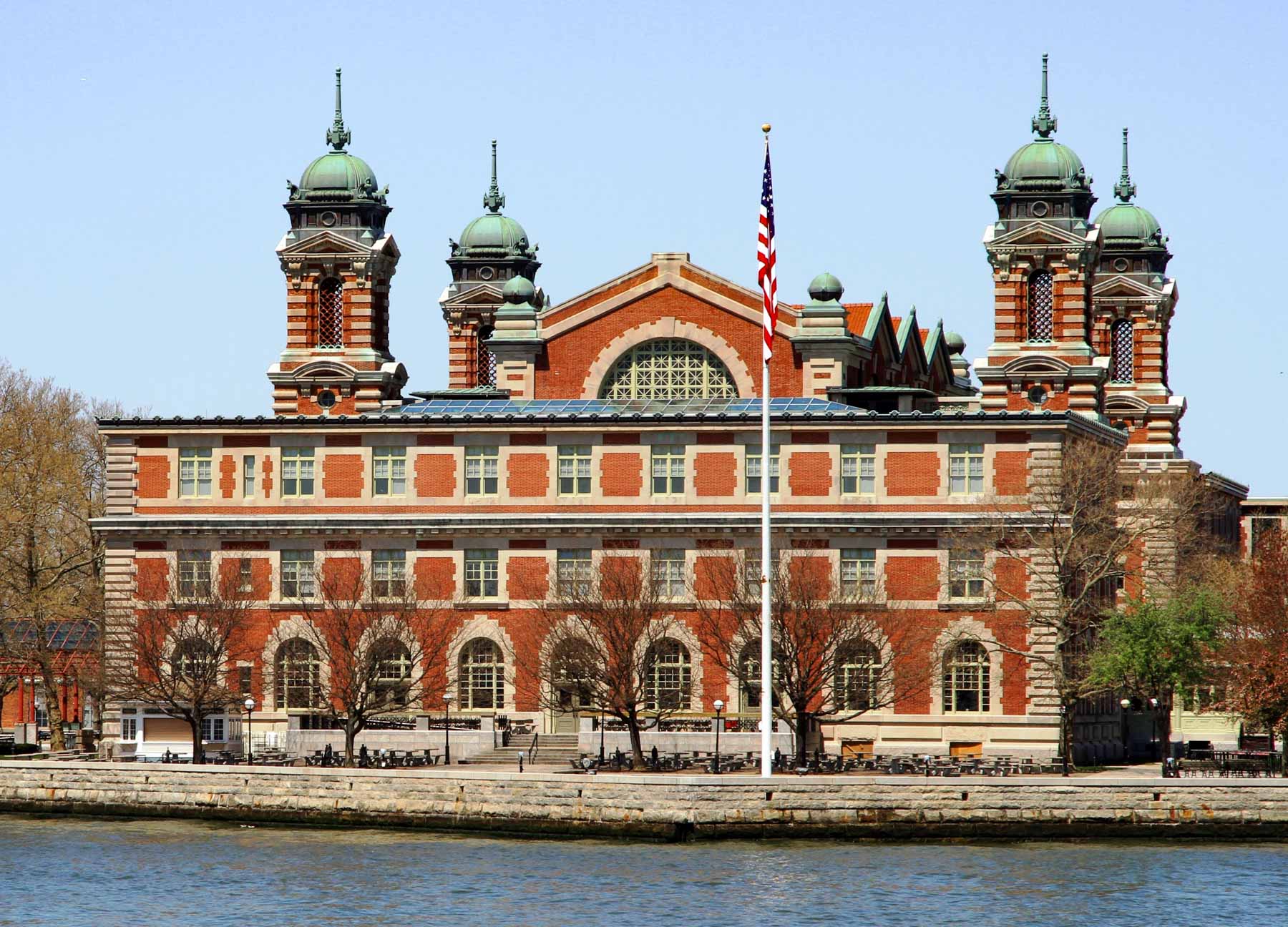
We’re on to the “Final Four.” At #4 is one of the most important places in American history. It’s Ellis Island.
Historic Ellis Island is a small island in New York Harbor that is famous for its role as the primary entry point for millions of immigrants to the United States between 1892 and 1954.
Today, it is part of the Statue of Liberty National Monument and is home to the Ellis Island National Museum of Immigration.
Before the opening of Ellis Island, immigrants to the United States were processed at Castle Garden, a facility located in Manhattan. However, as the number of immigrants increased, the facility became overcrowded, and a new processing center was needed.
In 1890, the federal government selected Ellis Island as the site for a new immigration processing center. The island had previously been used as a military fortification, but it was soon converted into a state-of-the-art facility for processing immigrants.
The first immigrant to pass through Ellis Island was Annie Moore, a 15-year-old girl from Ireland, on January 1, 1892.
Ellis Island Processed Millions Of Immigrants From Around The World
Over the next six decades, Ellis Island processed millions of immigrants from around the world. Immigrants would disembark from their ships and undergo a medical examination and questioning by immigration officials. Those who passed were allowed to enter the United States, while those who failed were sent back to their home countries.
Ellis Island closed as an immigration processing center in 1954, and the buildings fell into disrepair. In the 1980s, the island was restored and opened to the public as the Ellis Island National Museum of Immigration.
Today, visitors can tour the museum and learn about the experiences of the millions of immigrants who passed through Ellis Island on their way to a new life in the United States.
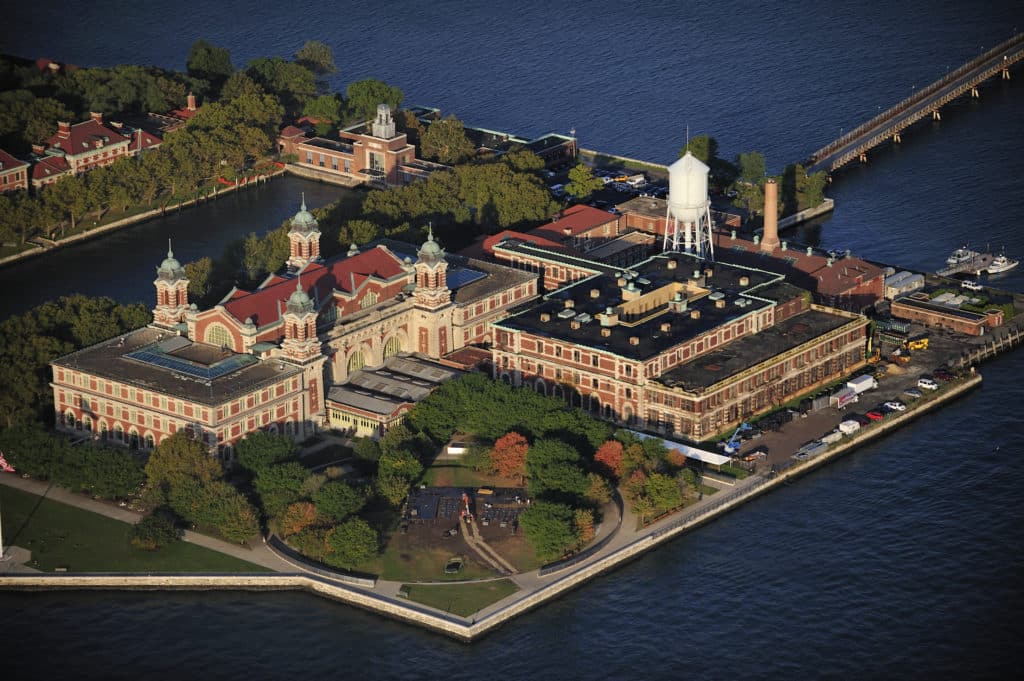
If you’re looking for other amazing historic sites in New York then check out: 20 MUST-SEE Historic Sites In New York
3. Lower Delaware National Wild & Scenic River
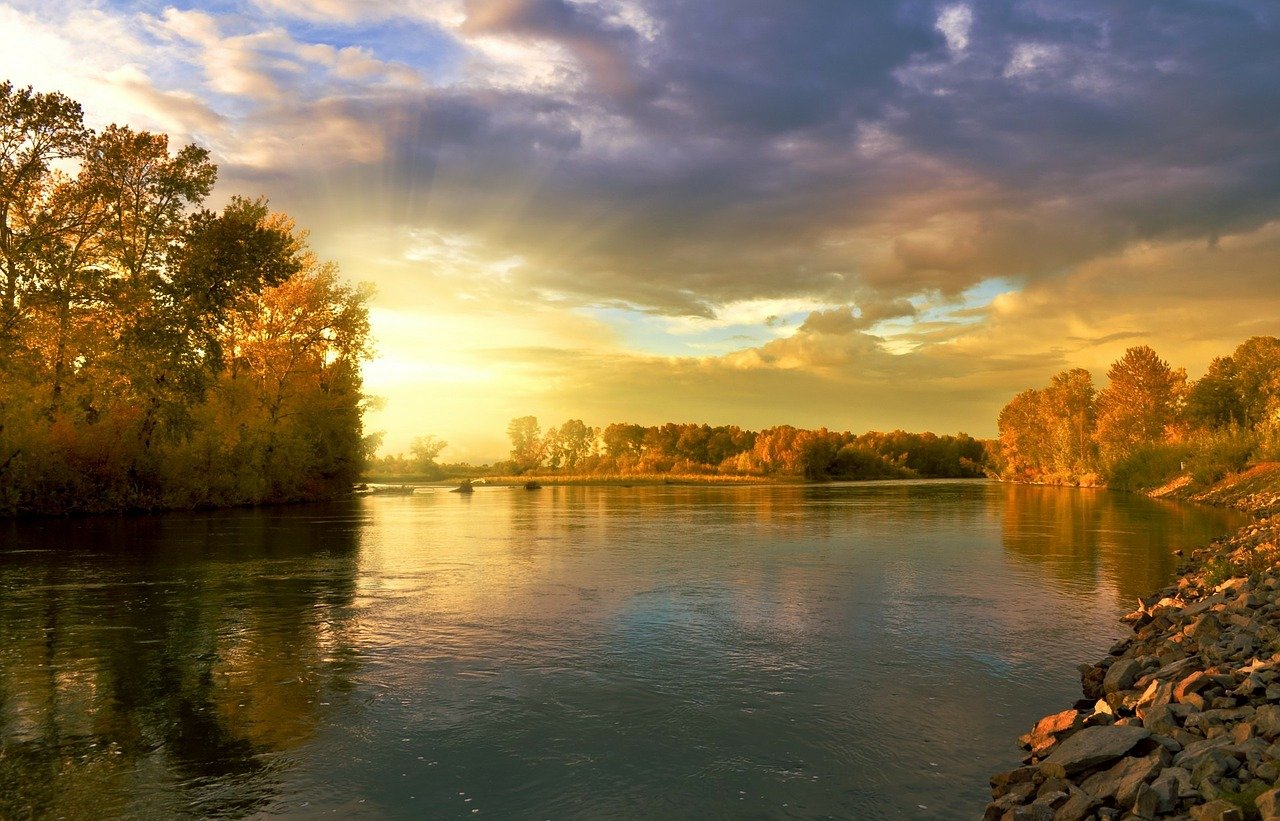
We move from a historic island to a truly amazing wild and scenic river. At #3 on our list of the Best Historic Sites In New Jersey is the Lower Delaware National Wild & Scenic River.
Some of the things to see and do at the Lower Delaware National Wild & Scenic River include:
- Canoeing and kayaking: The Delaware River offers over 40 miles of calm, slow-moving water for canoeing and kayaking. Visitors can rent a canoe or kayak and explore the river at their own pace.
- Fishing: The Delaware River is home to a variety of fish species, including smallmouth bass, catfish, and shad. Visitors can fish from the river’s banks or from a boat.
- Hiking: The Lower Delaware National Wild & Scenic River offers several hiking trails that take visitors through the area’s natural beauty. The trails range in difficulty and provide great opportunities to see wildlife and plants.
- Camping: There are several camping options available in the Lower Delaware National Wild & Scenic River, including designated campsites and backcountry camping.
- Wildlife viewing: The Lower Delaware National Wild & Scenic River is home to a wide variety of wildlife, including eagles, ospreys, and herons. Visitors can also see beavers, deer, and other mammals.
- Picnicking: Visitors can enjoy a picnic along the river, many spots are available for visitors to stop and enjoy a meal.
- Visitor center: There is a visitor center located in the park that provides information about the area’s history, geology, and natural resources.
- Ranger-led programs: The park offers ranger-led programs that provide visitors with an opportunity to learn more about the area’s natural and cultural resources.
There’s History There Too – Check Out Washington’s Crossing
I loved teaching about the Revolutionary War and one of my favorite battles was the one George Washington fought after his historic crossing of the Delaware River.
During the summer and autumn of 1776, the Continental Army under George Washington suffered a string of defeats in New York and northern New Jersey, necessitating the army’s retreat across the Delaware River to Pennsylvania.
Faced with expiring enlistments and plagued by inadequate supplies, on Christmas Day, 1776, Washington led 2,000 troops in a bold crossing of the Delaware River.
Early the next morning, the Continental Army attacked the surprised Hessian garrison. Nearly 1,000 Hessians were captured, along with their cannon and supplies.
You can visit Washington’s historic crossing at Washington’s Crossing, N.J. and Washington’s Crossing, PA.

If you’re looking for other amazing historic sites in Pennsylvania then check out: 15 MUST-SEE Historic Sites In Pennsylvania
2. Morristown National Historical Park
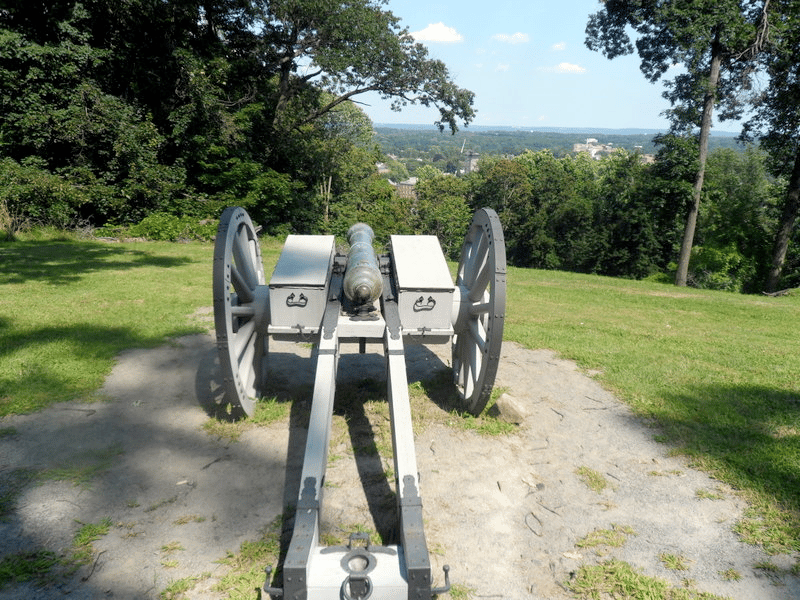
In the runner-up spot at #2 on our list of the Best Historic Sites In New Jersey is Morristown National Historical Park.
If you’re a fan of America’s first president then Morristown National Historical Park is a great place to visit. It commemorates the sites of General Washington and the Continental army’s winter encampment of December 1779 to June 1780, where they survived through what would be the coldest winter on record.
The park is home to General George Washington’s Headquarters (Ford Mansion), Fort Nonsense and Jockey Hollow. During two critical winters of the Revolutionary War, 1777 and 1779-80, the countryside in and around Morristown sheltered the main encampments of the American Continental Army.
The National Park Service preserves sites in the Morristown area occupied by the Continental Army and interprets the history and subsequent commemoration of these encampments and the extraordinary fortitude of the officers and enlisted men under Washington’s leadership.
Washington twice chose Morristown due to its strategic location, including proximity to New York City, defensible terrain, important communication routes, access to critical resources and a supportive community.
America’s First National Historical Park
America’s first national historical park on 1,676 acres, including a three-mile tour road, 24 miles of hiking trails, a visitor center, 18th century farm and several reconstructed soldier huts. Tours, special events and re-enactments are held throughout the year.
The park encompasses ground occupied by the army during the vast 1779-80 encampment and the site of the fortification from the 1777 encampment.
The Ford Mansion, where Washington made his headquarters, is an important feature of the park and recalls civilian contributions to the winning of independence.
The park also maintains a museum & library collection related to the encampments & George Washington, as well as items relating to pre- and post-Revolutionary America.
I recommend visiting the Washington Headquarters Museum. Points of interest there include: the American Style Gallery, Military Galley, Lloyd W. Smith Gallery and Ford Mansion.
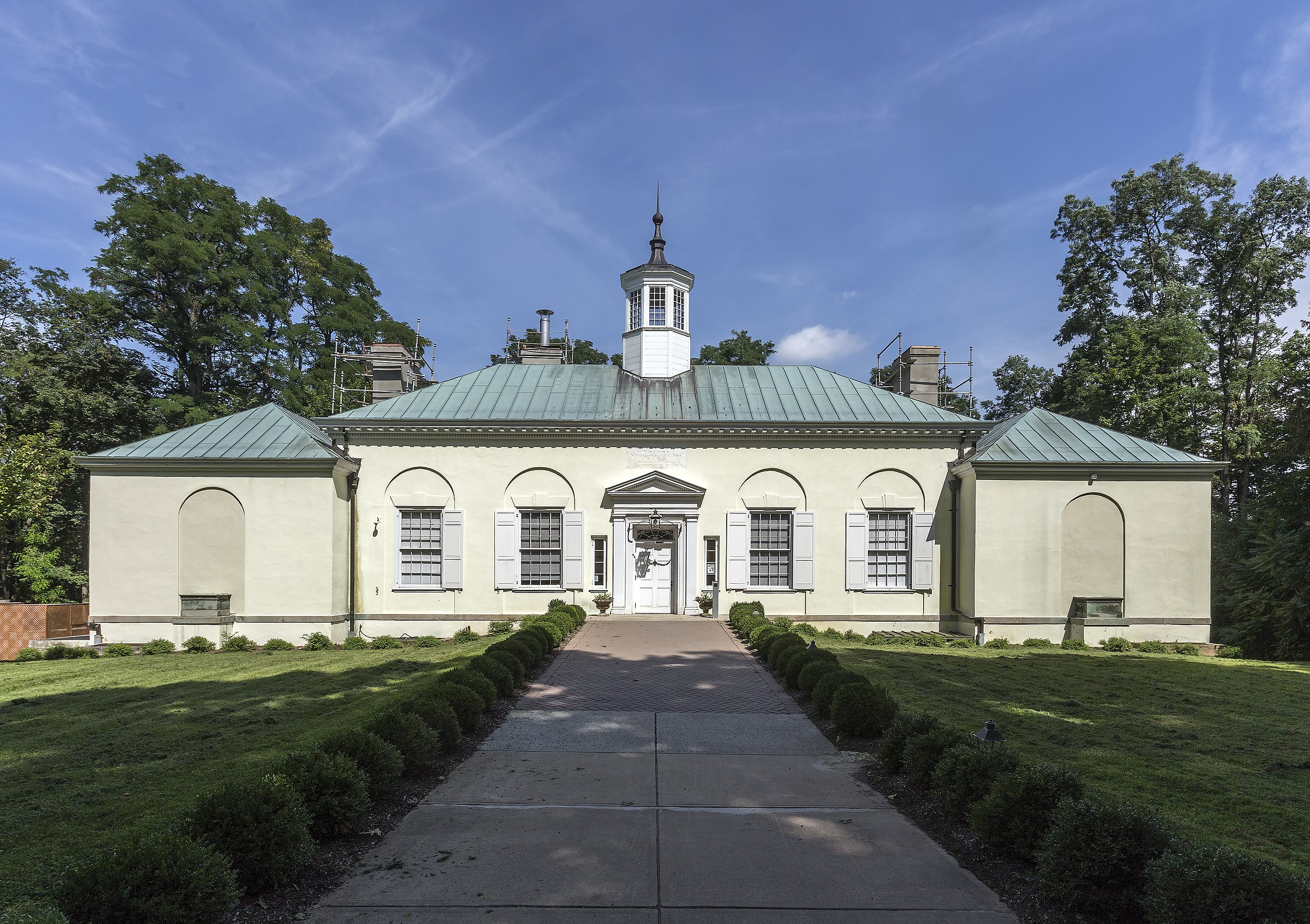
Check Out: 10 BEST Revolutionary War Sites In America
1. Thomas Edison National Historical Park
How many states can boast a place which celebrates a wizard? I can only think of one – Thomas Edison National Historical Park. Of course the wizard in question would be the Wizard of Menlo Park. And it’s More Than Just Parks #1 Historic Site In New Jersey.
One of the most famous and prolific inventors of all time, Thomas Alva Edison exerted a tremendous influence on modern life.
Edison is best known for inventing the incandescent light bulb, the phonograph, and the motion picture.
He developed his first invention at age 16. Edison’s working methods inspire modern research-and-development laboratories. Edison was known as the “Wizard of Menlo Park” for his work on the light bulb.
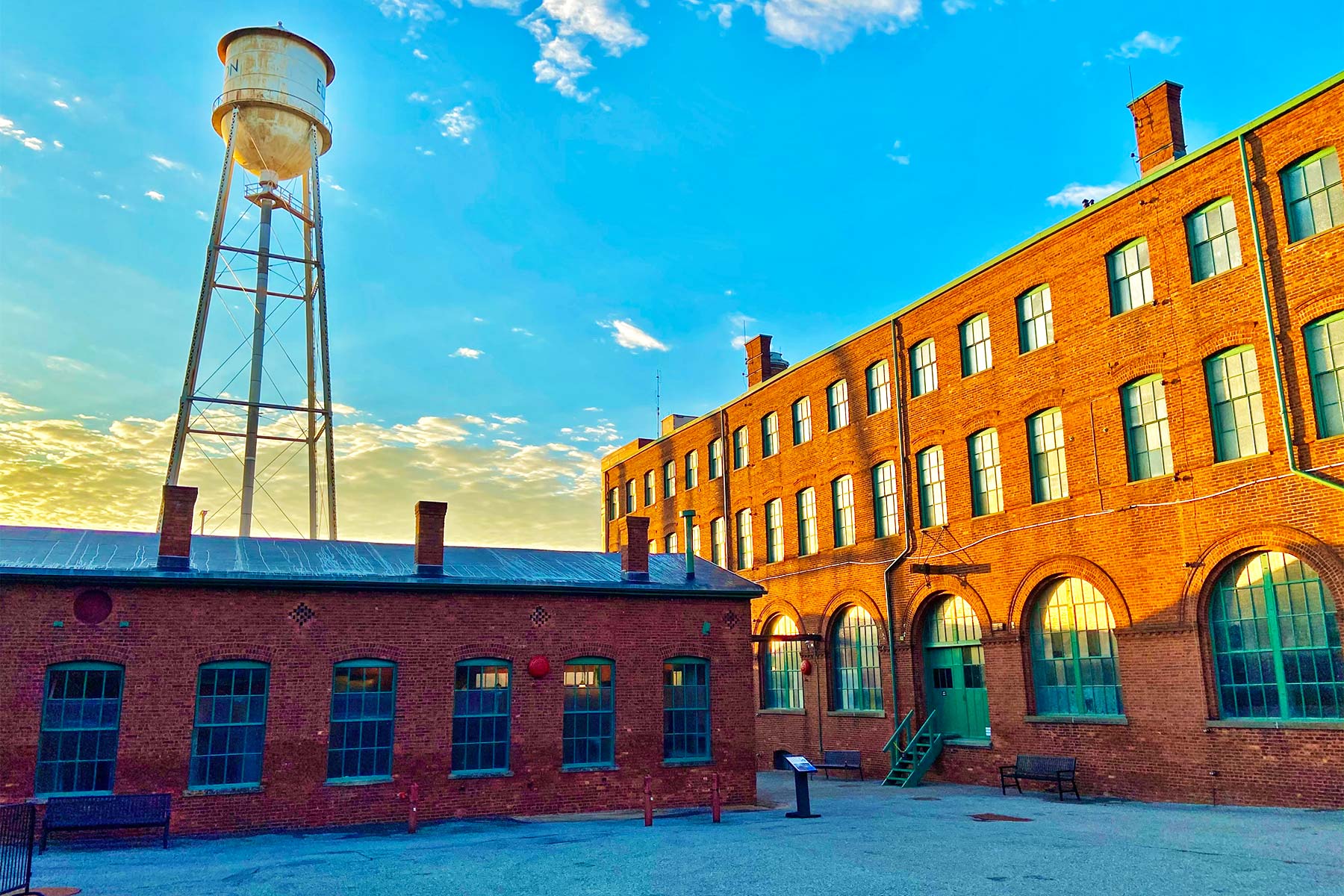
War Of The Currents
Among the employees of Thomas Edison was a young Nikola Tesla. Like Edison, Tesla was one of the greatest scientists and American inventors that have ever lived.
Tesla developed the alternating-current power system that provides electricity for homes and buildings. He also pioneered the field of radio communication and was granted more than 100 U.S. patents.
Edison and Tesla became involved in what became known as the “War of the Currents.” Edison championed the direct-current system, in which electrical current flows steadily in one direction, while Tesla and George Westinghouse promoted the alternating-current system, in which the current’s flow constantly alternates.
During the early years of electricity, direct current (shorthanded as DC) was the standard in the U.S. But there was one problem. Direct current is not easily converted to higher or lower voltages. Tesla believed that alternating current (or AC) was the solution to this problem.
By 1889, Edison Electric’s own subsidiaries were lobbying to add AC power transmission to their systems. In October of 1890, Edison Machine Works began developing AC-based equipment.
With Thomas Edison no longer involved with Edison General Electric, the war of currents came to a close with a financial merger.
To learn more about their struggle and its impact on America, I recommend: Tesla vs Edison: The Life-Long Feud that Electrified the World by Nigel Cawthorne.
Things To Do At Thomas Edison National Historical Park
Visitors can tour the following visitor facility buildings at the Laboratory Complex and Glenmont Estate Grounds:
- Visitor Center (Building 1) which includes the park orientation film and the museum store.
- Main Laboratory Building (Building 5) which includes Thomas Edison’s library, machine shops, music room, and other exhibits.
- Glenmont Greenhouse where volunteers from the Short Hills Garden Club and park volunteers care for a variety of exotic plants like those grown by the Edisons’.
- Glenmont Garage which contains Thomas Edison’s historic vehicles. (Source: NPS)
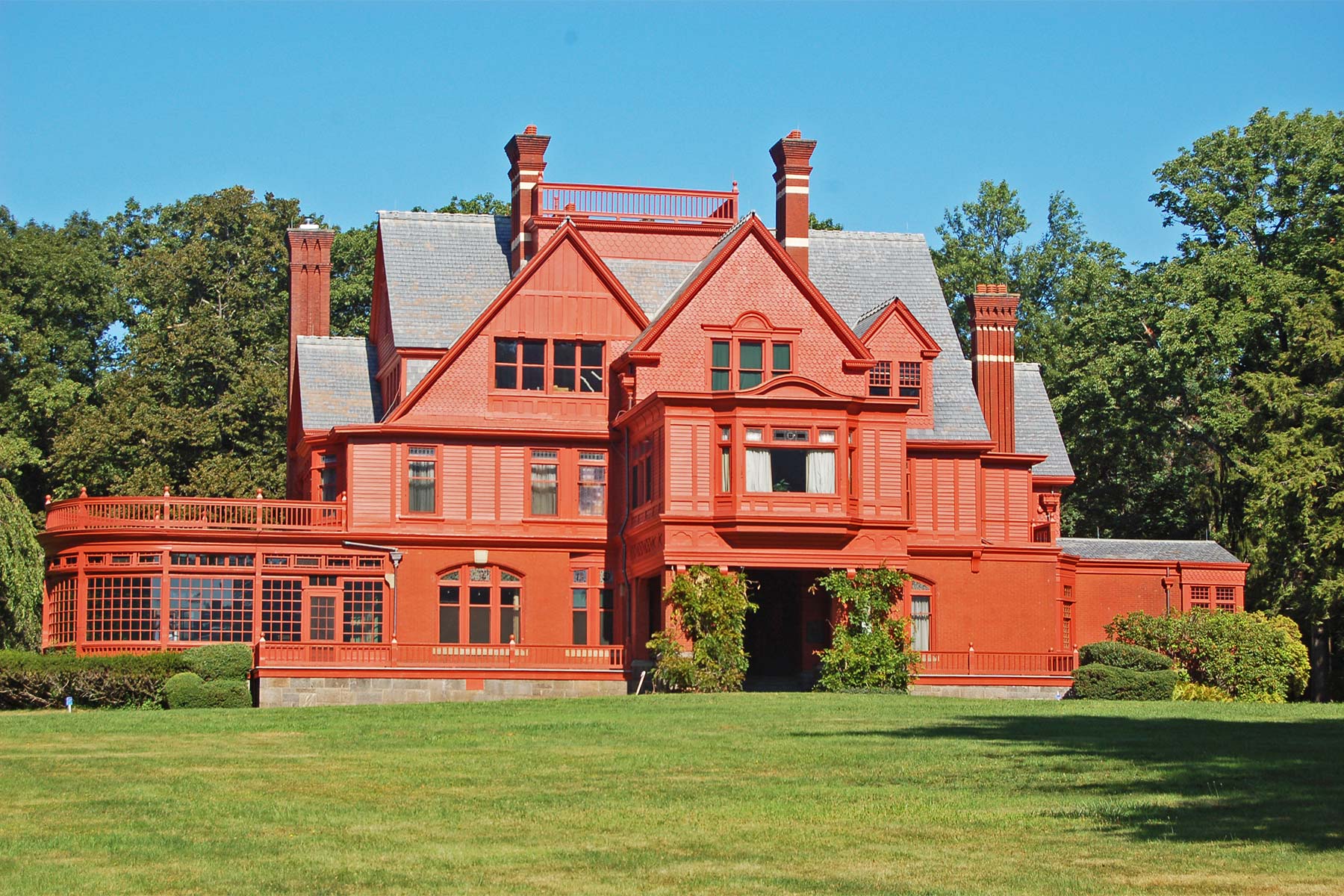
Learn More About The Wizard Of Menlo Park
One of the things that I love about researching and writing these articles is learning things I didn’t know. Hopefully, you, too, will learn things you didn’t know. For instance, did you know:
- In his youth, Thomas Edison built a chemistry lab on a train. Originally, he was selling candies and newspapers on the Grand Trunk Railroad. He then decided to set up a chemistry lab on the train. Not only that, but he build a printing press for his newspaper which he called
- Thomas Edison’s first invention was a vote-counting machine. Representatives could flip a switch and have their votes tallied electronically. Politicians didn’t like the idea, however, because it gave them no time for backroom deals. So much for election integrity!
- A museum claims to own Thomas Edison’s dying breath. The Henry Ford Museum, in Dearborn, Michigan, claims to have a test tube which contains Thomas Edison’s last breath.
To learn more about this extraordinary inventor, I recommend two excellent biographies.
One is Edison by Edmund Morris. The other is The Wizard of Menlo Park: How Thomas Alva Edison Invented the Modern World by Randall E. Stross.
Check Out: List Of 128 BEST US National Monuments Ranked
List Of Historic Sites In New Jersey
- Thomas Edison National Historical Park
- Morristown National Historical Park
- Lower Delaware National Wild & Scenic River
- Ellis Island
- Paterson Great Falls National Historical Park
- Washington-Rochambeau Revolutionary Route National Historic Trail
- Appalachian National Scenic Trail
- Grover Cleveland Birthplace
- Allaire Village
- Monmouth Battlefield
- The Sterling Hill Mining Museum
- William Trent House Museum
- Weehawken Dueling Grounds
- Absecon Lighthouse
- Lambert Tower
Why Trust Us About Historic Sites In New Jersey?
We’re Jim Pattiz and Will Pattiz, collectively known as the Pattiz Brothers and we absolutely LOVE the national parks.
You should probably know that we don’t just make this stuff up out of thin air. We’ve spent our entire adult lives exploring and filming America’s national parks and public lands.
We’ve worked with the National Park Service, the Department of Interior, USDA, U.S. Forest Service, and more for years creating films on important places and issues. Our work has been featured in leading publications all over the world and even some people outside of our immediate family call us experts on the national parks.
And, in 2018, our father – having spent a lifetime teaching history – joined us so that he could help us to tell the stories behind these amazing places.
Meet The Parks Brothers
We Hope You’ll Follow Our Journey

Our goal here at More Than Just Parks is to share the beauty of America’s national parks and public lands through stunning short films in an effort to get Americans and the world to see the true value in land conservation.
We hope you’ll follow our journey through the parks and help us to keep them the incredible places that they are. If you’re interested in joining the adventure then sign up below!
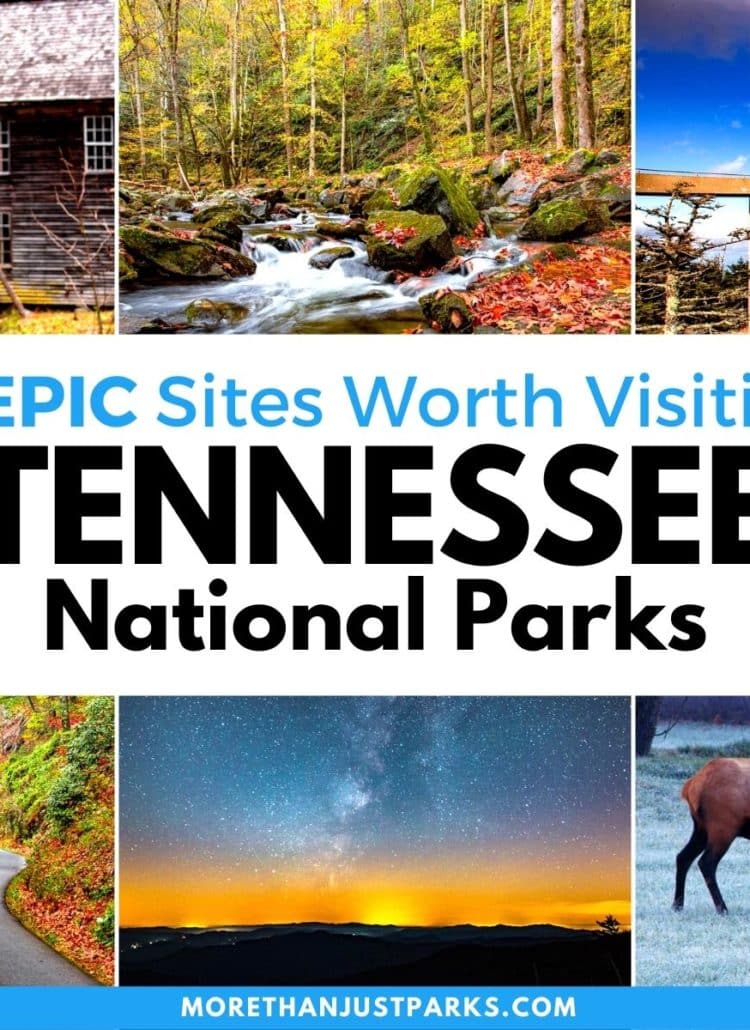




Leave a Reply